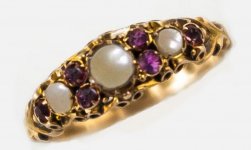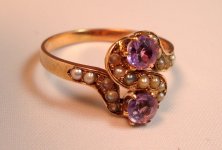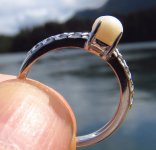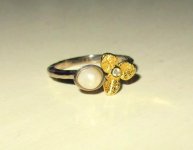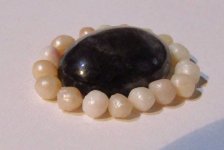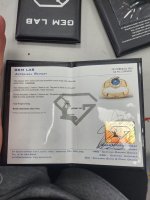Hi Alexzoe,
Welcome to Pearl-Guide and congratulations on your finds. I'm away from home at the moment, enjoying some vacation time, a school reunion and some quality time with my family, so I'll apologize for not being timely with a reply.
The attached images clearly present a nice cache of natural pearls from Blue Mussels (Mytilus edulus). Color, shape and size being very typical.
I'm curious of other things, which may be helpful of some possibilties for these. In the interest of conservation, you need not divulge a specific location, but it would be useful to know the country, state or province of origin. I've not commented on luster (yet) for a couple of reasons. First, the time of year matters when natural pearls are collected. Winter harvesting invariably provides the greatest opportunity for higher luster, where during summer months often cause natural pearls to be occluded by calcite, which is the bane of any farmer or collector.
For the moment, I will ask for another array of photographs, that I may be able to examine these for surface quality. Cell phones are not the best camera for this task. Most quick snap, bridge or SLR cameras have better options for capturing images, particularly in MACRO mode. Place any combination of pearls on a white surface, so the camera does not struggle with backgrounds which can distract from a critical focus on the pearls themselves. Normally many suggest a flat white background, but I've had good results using a shiny surface because dramatic shadows aid with contrast and critical focus. Also some suggest using indirect light, but I tend to use more direct lighting so long as it is balanced. Either natural light during mid-day or midrange (5400K) artificial light. Higher or lower frequencies tend to cause the target to appear too blue or red.
Mytilus are pteriomorphs, which suggest they've evolved similar to the highly nacreous species used by pearl farmers. Very often several (albeit tiny) pearls may be found in a single mussel and within several mussels in the same patch. This is good news, because some specimens may present as world class and quite desirable in the market place. However at PG, we tend to avoid the subjectivity and liability of evaluated appraisals. We'd all agree beauty is in the eye of the beholder, hence arriving at a pricing agreement ought to be considerate of need, rarity and useful workability in crafting. At the very least, we could be of some assistance whether an agreed price is too outrageous whether low or high.
Likewise, there is no need to send them to a gem lab. It's expensive and the origin of these are not questionable. In my work history, I've learned a great difference between scientific value and gem quality. Sustainability and licensing are important factors, after all the reckless abandon (and needless decimation) of days gone by are important things to consider when proposing any disposition of natural pearls.
Meanwhile, it may be helpful to visit this thread:
Candled Natural Pearls
In the thread, I have posted several views of natural pearls from California Mussels (Mytilus californianus)
Congratulations on your discovery and finds, I'll look foward to answers, other questions and new images and respond soon as able.
Dave
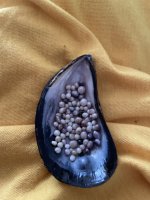 2573E161-0C41-4991-A3A4-29E79C2B32F4.jpeg3.6 MB · Views: 260
2573E161-0C41-4991-A3A4-29E79C2B32F4.jpeg3.6 MB · Views: 260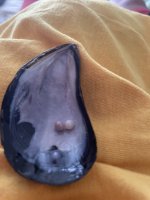 C94F269A-E3DD-4B8F-B7F1-9F2A03814DDE.jpeg3.1 MB · Views: 281
C94F269A-E3DD-4B8F-B7F1-9F2A03814DDE.jpeg3.1 MB · Views: 281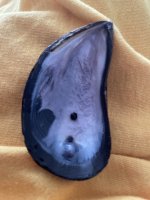 56855348-B54D-442C-ABE3-AA1D1A4160AC.jpeg2.9 MB · Views: 280
56855348-B54D-442C-ABE3-AA1D1A4160AC.jpeg2.9 MB · Views: 280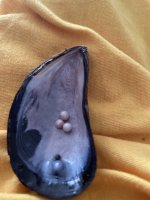 01D67EF1-79D6-4E70-A712-7B208295EF2F.jpeg3.3 MB · Views: 266
01D67EF1-79D6-4E70-A712-7B208295EF2F.jpeg3.3 MB · Views: 266 1652586D-10AE-4F11-A3CC-A5F70AEAFA80.jpeg1.9 MB · Views: 246
1652586D-10AE-4F11-A3CC-A5F70AEAFA80.jpeg1.9 MB · Views: 246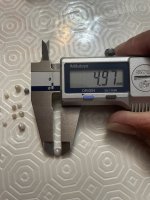 80771E83-19E0-453C-A978-C69F7E8E2BBC.jpeg1.6 MB · Views: 234
80771E83-19E0-453C-A978-C69F7E8E2BBC.jpeg1.6 MB · Views: 234 2D43189E-40A5-418E-9DCF-0BF7864E2E21.jpeg1.8 MB · Views: 306
2D43189E-40A5-418E-9DCF-0BF7864E2E21.jpeg1.8 MB · Views: 306
